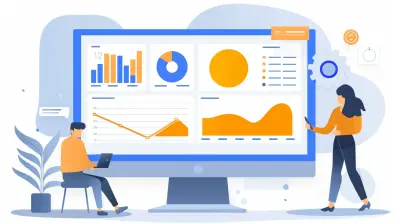Data-Driven Product Development: How to Make Better Decisions
20 October 2025
Ever feel like you're playing a guessing game when it comes to developing a new product? You're not alone. Many businesses rely on intuition and gut feelings, only to realize later that their "brilliant idea" didn’t quite hit the mark.
Enter data-driven product development—a game-changing approach that removes the guesswork and replaces it with real facts, figures, and customer insights. It’s like having a crystal ball, except it’s backed by numbers instead of magic.
So, how can you harness the power of data to build better products, make smarter decisions, and avoid costly flops? Let’s dive in.

What Is Data-Driven Product Development?
Data-driven product development is the process of using data to guide decision-making at every stage of creating a product. Rather than relying on assumptions or industry trends, companies use analytics, customer feedback, and key performance indicators (KPIs) to shape their products.Think of it like cooking a recipe with exact measurements, rather than just throwing in random ingredients and hoping it tastes good.

Why Guessing Won’t Cut It Anymore
Gone are the days when companies could launch a product based on a hunch and expect success. Consumers today are more informed and have higher expectations. If you don’t give them exactly what they want, they’ll find someone else who will.By leveraging data, you can:
- Identify customer pain points before building your product
- Test concepts with real users instead of assuming they’ll love your idea
- Optimize features based on actual usage, not just industry trends
- Reduce risks by eliminating costly mistakes before it's too late
In short, data helps you create products that people actually want—without the trial-and-error headache.

The Key Steps in Data-Driven Product Development
Now, let's break down the process of how data can turn your product development strategy from a shot in the dark to a well-lit path to success.1. Define Clear Goals
Before you start collecting data, you need to know what you're trying to achieve. Are you looking to improve an existing product? Identify a gap in the market? Reduce churn?Setting clear, measurable goals ensures that you’re collecting relevant data—not just drowning in numbers that don’t actually serve a purpose.
✅ Example: Instead of saying, "We want to create the best fitness app," say, "We want to increase user retention on our fitness app by 20% over the next six months."
2. Gather the Right Data
Not all data is useful. Collecting random numbers just because they look impressive is like hoarding ingredients without knowing what dish you’re making.Instead, focus on:
- Customer feedback: Surveys, reviews, and direct conversations
- User behavior analytics: Heatmaps, session recordings, and engagement metrics
- Market research: Trends, competitor analysis, and industry reports
- A/B testing results: What version of your product or feature performs better?
3. Analyze and Interpret the Data
Having data is great, but knowing what to do with it is even better.Look for patterns and insights. Are users struggling with a particular feature? Is there one feature that gets significantly more engagement than others? Does your target audience align with your current users?
Data is like a puzzle. If you take the time to piece it together, you’ll start to see a clearer picture of what works and what doesn’t.
4. Prototype and Validate
Once you spot trends and opportunities, don’t go all in just yet. Test small first. Create a prototype or Minimum Viable Product (MVP) and put it into the hands of real users.User feedback at this stage is priceless. It allows you to tweak, refine, and perfect your product before you fully launch.
✅ Example: If you're designing an app, launch a beta version to a select group. Track how they use it and what feedback they give before rolling it out to the masses.
5. Implement and Monitor Performance
Once your product is out in the wild, the data-driven approach doesn’t stop. You need to continuously track key metrics to ensure it’s meeting its goals.Keep an eye on:
- Retention rates
- User engagement
- Conversion rates
- Feature adoption rates
If something isn’t performing as expected, pivot. Optimize based on real-time insights rather than stubbornly sticking to an underwhelming feature.
6. Iterate and Improve
Product development is never a "one-and-done" deal. Consumer preferences, market conditions, and tech advancements change constantly.Successful companies use data-driven iteration—analyzing user behavior, making continuous updates, and improving their product over time.
✅ Example: Netflix started as a DVD rental company. Through data-driven insights, they pivoted to streaming, then to original content. Now, they dominate the entertainment industry.

Benefits of Data-Driven Decision Making
Wondering why you should embrace a data-first approach? Here’s what you gain:✅ Reduced Risk
Making decisions based on real user data rather than assumptions significantly decreases the chances of flopping.✅ Faster Time-to-Market
Data helps prioritize what truly matters, speeding up the development process by eliminating unnecessary guesswork.✅ Higher Customer Satisfaction
When you build a product around customer needs, they actually enjoy using it—which means more brand loyalty for you.✅ Better ROI
Investing in what works ensures that your time, money, and resources go into something that delivers real returns.Common Mistakes to Avoid in Data-Driven Development
Before you rush off to analyze spreadsheets, beware of these common pitfalls:❌ Focusing on Vanity Metrics
Just because a metric looks impressive doesn’t mean it’s valuable. High website traffic means nothing if visitors don’t convert into paying customers.❌ Ignoring Qualitative Data
Numbers are great, but context matters. Customer feedback, social media sentiment, and interviews provide insights numbers alone can’t reveal.❌ Overcomplicating the Process
You don’t need a PhD in Data Science to get started. Even basic customer surveys and A/B tests can provide game-changing insights.❌ Sticking to Data That Confirms Biases
Be open to data telling you something you don’t want to hear. It’s better to adjust early than to launch something doomed to fail.
Final Thoughts
Data-driven product development isn’t just a trend—it’s a necessity. Businesses that leverage real data outperform those that rely on gut feelings.The best products aren’t dreamed up in boardrooms; they’re refined through research, feedback, and continuous improvement.
So, next time you’re faced with a big product decision, ditch the guessing game. Let data be your guide—it might just be the secret weapon you need to build something truly impactful.
all images in this post were generated using AI tools
Category:
Product DevelopmentAuthor:

Matthew Scott
Discussion
rate this article
1 comments
Alessia Flores
Great insights on leveraging data for product development! Implementing data-driven strategies can significantly enhance decision-making and ultimately lead to more successful products. Thank you!
October 30, 2025 at 12:30 PM


